Introduction to Amplifiers | Analog and Digital Electronics - Electrical Engineering (EE) PDF Download
Amplifier is the generic term used to describe a circuit which produces and increased version of its input signal. However as we will see in this introduction to the amplifier tutorial, not all amplifier circuits are the same as they are classified according to their circuit configurations and modes of operation.
In “Electronics”, small signal amplifiers are commonly used devices as they have the ability to amplify a relatively small input signal, for example from a Sensor such as a photo-device, into a much larger output signal to drive a relay, lamp or loudspeaker for example.
There are many forms of electronic circuits classed as amplifiers, from Operational Amplifiers and Small Signal Amplifiers up to Large Signal and Power Amplifiers. The classification of an amplifier depends upon the size of the signal, large or small, its physical configuration and how it processes the input signal, that is the relationship between input signal and current flowing in the load.
The type or classification of an Amplifier is given in the following table.
| Type of Signal | Type of Configuration | Classification | Frequency of Operation |
| Small Signal | Common Emitter | Class A Amplifier | Direct Current (DC) |
| Large Signal | Common Base | Class B Amplifier | Audio Frequencies (AF) |
| Common Collector | Class AB Amplifier | Radio Frequencies (RF) | |
| Class C Amplifier | VHF, UHF and SHF Frequencies |
Amplifiers can be thought of as a simple box or block containing the amplifying device, such as a Bipolar Transistor, Field Effect Transistor or Operational Amplifier, which has two input terminals and two output terminals (ground being common) with the output signal being much greater than that of the input signal as it has been “Amplified”.
An ideal signal amplifier will have three main properties: Input Resistance or (RIN), Output Resistance or (ROUT) and of course amplification known commonly as Gain or (A). No matter how complicated an amplifier circuit is, a general amplifier model can still be used to show the relationship of these three properties.
Ideal Amplifier Model
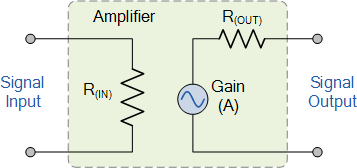
The amplified difference between the input and output signals is known as the Gain of the amplifier. Gain is basically a measure of how much an amplifier “amplifies” the input signal. For example, if we have an input signal of 1 volt and an output of 50 volts, then the gain of the amplifier would be “50”. In other words, the input signal has been increased by a factor of 50. This increase is called Gain.
Amplifier gain is simply the ratio of the output divided-by the input. Gain has no units as its a ratio, but in Electronics it is commonly given the symbol “A”, for Amplification. Then the gain of an amplifier is simply calculated as the “output signal divided by the input signal”.
Amplifier Gain
The introduction to the amplifier gain can be said to be the relationship that exists between the signal measured at the output with the signal measured at the input. There are three different kinds of amplifier gain which can be measured and these are: Voltage Gain ( Av ), Current Gain ( Ai ) and Power Gain ( Ap ) depending upon the quantity being measured with examples of these different types of gains are given below.
Amplifier Gain of the Input Signal

Voltage Amplifier Gain

Current Amplifier Gain

Power Amplifier Gain

Note that for the Power Gain you can also divide the power obtained at the output with the power obtained at the input. Also when calculating the gain of an amplifier, the subscripts v, i and p are used to denote the type of signal gain being used.
The power gain (Ap) or power level of the amplifier can also be expressed in Decibels, (dB). The Bel (B) is a logarithmic unit (base 10) of measurement that has no units. Since the Bel is too large a unit of measure, it is prefixed with deci making it Decibels instead with one decibel being one tenth (1/10th) of a Bel. To calculate the gain of the amplifier in Decibels or dB, we can use the following expressions.
- Voltage Gain in dB: av = 20*log(Av)
- Current Gain in dB: ai = 20*log(Ai)
- Power Gain in dB: ap = 10*log(Ap)
Note that the DC power gain of an amplifier is equal to ten times the common log of the output to input ratio, where as voltage and current gains are 20 times the common log of the ratio. Note however, that 20dB is not twice as much power as 10dB because of the log scale.
Also, a positive value of dB represents a Gain and a negative value of dB represents a Loss within the amplifier. For example, an amplifier gain of +3dB indicates that the amplifiers output signal has “doubled”, (x2) while an amplifier gain of -3dB indicates that the signal has “halved”, (x0.5) or in other words a loss.
The -3dB point of an amplifier is called the half-power point which is -3dB down from maximum, taking 0dB as the maximum output value.
Introduction to the Amplifier Example No1
Determine the Voltage, Current and Power Gain of an amplifier that has an input signal of 1mA at 10mV and a corresponding output signal of 10mA at 1V. Also, express all three gains in decibels, (dB).
The Various Amplifier Gains:
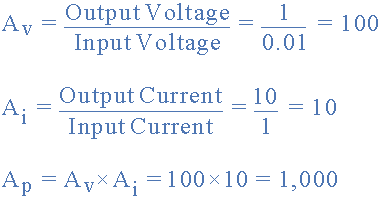
Amplifier Gains given in Decibels (dB):
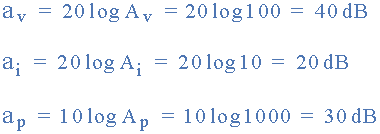
Then the amplifier has a Voltage Gain, (Av) of 100, a Current Gain, (Ai) of 10 and a Power Gain, (Ap) of 1,000
Generally, amplifiers can be sub-divided into two distinct types depending upon their power or voltage gain. One type is called the Small Signal Amplifier which include pre-amplifiers, instrumentation amplifiers etc. Small signal amplifies are designed to amplify very small signal voltage levels of only a few micro-volts (μV) from sensors or audio signals.
The other type are called Large Signal Amplifiers such as audio power amplifiers or power switching amplifiers. Large signal amplifiers are designed to amplify large input voltage signals or switch heavy load currents as you would find driving loudspeakers.
Introduction to the Amplifier of Power Amplifiers
The Small Signal Amplifier is generally referred to as a “Voltage” amplifier because they usually convert a small input voltage into a much larger output voltage. Sometimes an amplifier circuit is required to drive a motor or feed a loudspeaker and for these types of applications where high switching currents are needed Power Amplifiers are required.
As their name suggests, the main job of a “Power Amplifier” (also known as a large signal amplifier), is to deliver power to the load, and as we know from above, is the product of the voltage and current applied to the load with the output signal power being greater than the input signal power. In other words, a power amplifier amplifies the power of the input signal which is why these types of amplifier circuits are used in audio amplifier output stages to drive loudspeakers.
The power amplifier works on the basic principle of converting the DC power drawn from the power supply into an AC voltage signal delivered to the load. Although the amplification is high the efficiency of the conversion from the DC power supply input to the AC voltage signal output is usually poor.
The perfect or ideal amplifier would give us an efficiency rating of 100% or at least the power “IN” would be equal to the power “OUT”. However, in reality this can never happen as some of the power is lost in the form of heat and also, the amplifier itself consumes power during the amplification process. Then the efficiency of an amplifier is given as:
Amplifier Efficiency

Ideal Amplifier
We can know specify the characteristics for an ideal amplifier from our discussion above with regards to its Gain, meaning voltage gain:
- The amplifiers gain, ( A ) should remain constant for varying values of input signal.
- Gain is not be affected by frequency. Signals of all frequencies must be amplified by exactly the same amount.
- The amplifiers gain must not add noise to the output signal. It should remove any noise that is already exists in the input signal.
- The amplifiers gain should not be affected by changes in temperature giving good temperature stability.
- The gain of the amplifier must remain stable over long periods of time.
Electronic Amplifier Classes
The classification of an amplifier as either a voltage or a power amplifier is made by comparing the characteristics of the input and output signals by measuring the amount of time in relation to the input signal that the current flows in the output circuit.
We saw in the Common Emitter Transistor tutorial that for the transistor to operate within its “Active Region” some form of “Base Biasing” was required. This small Base Bias voltage added to the input signal allowed the transistor to reproduce the full input waveform at its output with no loss of signal.
However, by altering the position of this Base bias voltage, it is possible to operate an amplifier in an amplification mode other than that for full waveform reproduction. With the introduction to the amplifier of a Base bias voltage, different operating ranges and modes of operation can be obtained which are categorized according to their classification. These various mode of operation are better known as Amplifier Class.
Audio power amplifiers are classified in an alphabetical order according to their circuit configurations and mode of operation. Amplifiers are designated by different classes of operation such as class “A”, class “B”, class “C”, class “AB”, etc. These different amplifier classes range from a near linear output but with low efficiency to a non-linear output but with a high efficiency.
No one class of operation is “better” or “worse” than any other class with the type of operation being determined by the use of the amplifying circuit. There are typical maximum conversion efficiencies for the various types or class of amplifier, with the most commonly used being:
- Class A Amplifier – has low efficiency of less than 40% but good signal reproduction and linearity.
- Class B Amplifier – is twice as efficient as class A amplifiers with a maximum theoretical efficiency of about 70% because the amplifying device only conducts (and uses power) for half of the input signal.
- Class AB Amplifier – has an efficiency rating between that of Class A and Class B but poorer signal reproduction than Class A amplifiers.
- Class C Amplifier – is the most efficient amplifier class but distortion is very high as only a small portion of the input signal is amplified therefore the output signal bears very little resemblance to the input signal. Class C amplifiers have the worst signal reproduction.
The Class A Amplifier
The basic configuration of a class-A amplifier provides a good introduction to the amplifier circuit. Class A Amplifier operation is where the entire input signal waveform is faithfully reproduced at the amplifiers output terminal as the transistor is perfectly biased within its active region. This means that the switching transistor is never driven into its cut-off or saturation regions. The result is that the AC input signal is perfectly “centred” between the amplifiers upper and lower signal limits as shown below.
Class A Amplifier Output Waveform

A Class-A amplifier configuration uses the same switching transistor for both halves of the output waveform and due to its central biasing arrangement, the output transistor always has a constant DC biasing current, (ICQ) flowing through it, even if there is no input signal present. In other words the output transistors never turns “OFF” and is in a permenant state of idle.
This results in the Class-A type of operation being somewhat inefficient as its conversion of the DC supply power to the AC signal power delivered to the load is usually very low.
Due to this centered biasing point, the output transistor of a Class-A amplifier can get very hot, even when there is no input signal present, so some form of heat sinking is required. The DC biasing current flowing through the collector of the transistor (ICQ) is equal to the current flowing through the collector load. Thus a Class-A amplifier is very inefficient as most of this DC power is converted to heat.
Class B Amplifier
Unlike the Class-A amplifier mode of operation above that uses a single transistor for its output power stage, the Class-B Amplifier uses two complimentary transistors (either an NPN and a PNP or a NMOS and a PMOS) to amplify each half of the output waveform.
One transistor conducts for only one-half of the signal waveform while the other conducts for the other or opposite half of the signal waveform. This means that each transistor spends half of its time in the active region and half its time in the cut-off region thereby amplifying only 50% of the input signal.
Class-B operation has no direct DC bias voltage unlike the class-A amplifier, but instead the transistor only conducts when the input signal is greater than the base-emitter voltage (VBE) and for silicon transistors, this is about 0.7v. Therefore with zero input signal there is zero output. As only half the input signal is presented at the amplifiers output this improves the amplifier efficiency over the previous Class-A configuration as shown below.
Class B Amplifier Output Waveform
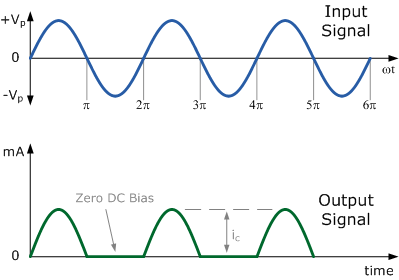
In a Class-B amplifier, no DC voltage is used to bias the transistors, so for the output transistors to start to conduct each half of the waveform, both positive and negative, they need the base-emitter voltage VBE to be greater than the 0.7v forward voltage drop required for a standard bipolar transistor to start conducting.
Thus the lower part of the output waveform which is below this 0.7v window will not be reproduced accurately. This results in a distorted area of the output waveform as one transistor turns “OFF” waiting for the other to turn back “ON” once VBE > 0.7V. The result is that there is a small part of the output waveform at the zero voltage cross over point which will be distorted. This type of distortion is called Crossover Distortion and is looked at later on in this section.
Class AB Amplifier
The Class-AB Amplifier is a compromise between the Class-A and the Class-B configurations above. While Class-AB operation still uses two complementary transistors in its output stage a very small biasing voltage is applied to the Base of each transistor to bias them close to their cut-off region when no input signal is present.
An input signal will cause the transistor to operate as normal within its active region, eliminating any crossover distortion which is always present in the class-B configuration. A small biasing Collector current (ICQ) will flow through the transistor when there is no input signal present, but generally it is much less than that for the Class-A amplifier configuration.
Thus each transistor is conducting, “ON” for a little more than half a cycle of the input waveform. The small biasing of the Class-AB amplifier configuration improves both the efficiency and linearity of the amplifier circuit compared to a pure Class-A configuration above.
Class AB Amplifier Output Waveform
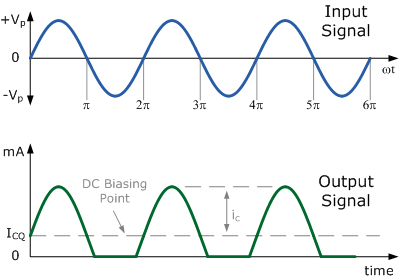
As an introduction to the amplifier, when designing amplifier circuits, the class of operation of an amplifier is very important as it determines the amount of transistor biasing required for its operation as well as the maximum amplitude of the input signal.
Amplifier classification takes into account the portion of the input signal in which the output transistor conducts as well as determining both the efficiency and the amount of power that the switching transistor both consumes and dissipates in the form of wasted heat. Here we can make a comparison between the most common types of amplifier classifications in the following table.
Power Amplifier Classes
| Class | A | B | C | AB |
| Conduction Angle | 360o | 180o | Less than 90o | 180 to 360o |
| Position of the Q-point | Centre Point of the Load Line | Exactly on the X-axis | Below the X-axis | In between the X-axis and the Centre Load Line |
| Overall Efficiency | Poor 25 to 30% | Better 70 to 80% | Higher than 80% | Better than A but less than B 50 to 70% |
| Signal Distortion | None if Correctly Biased | At the X-axis Crossover Point | Large Amounts | Small Amounts |
Badly designed amplifiers especially the Class “A” types may also require larger power transistors, more expensive heat sinks, cooling fans, or even an increase in the size of the power supply required to deliver the extra wasted power required by the amplifier. Power converted into heat from transistors, resistors or any other component for that matter, makes any electronic circuit inefficient and will result in the premature failure of the device.
So why use a Class A amplifier if its efficiency is less than 40% compared to a Class B amplifier that has a higher efficiency rating of over 70%. Basically, a Class A amplifier gives a much more linear output meaning that it has, Linearity over a larger frequency response even if it does consume large amounts of DC power.
|
135 videos|181 docs|71 tests
|





















